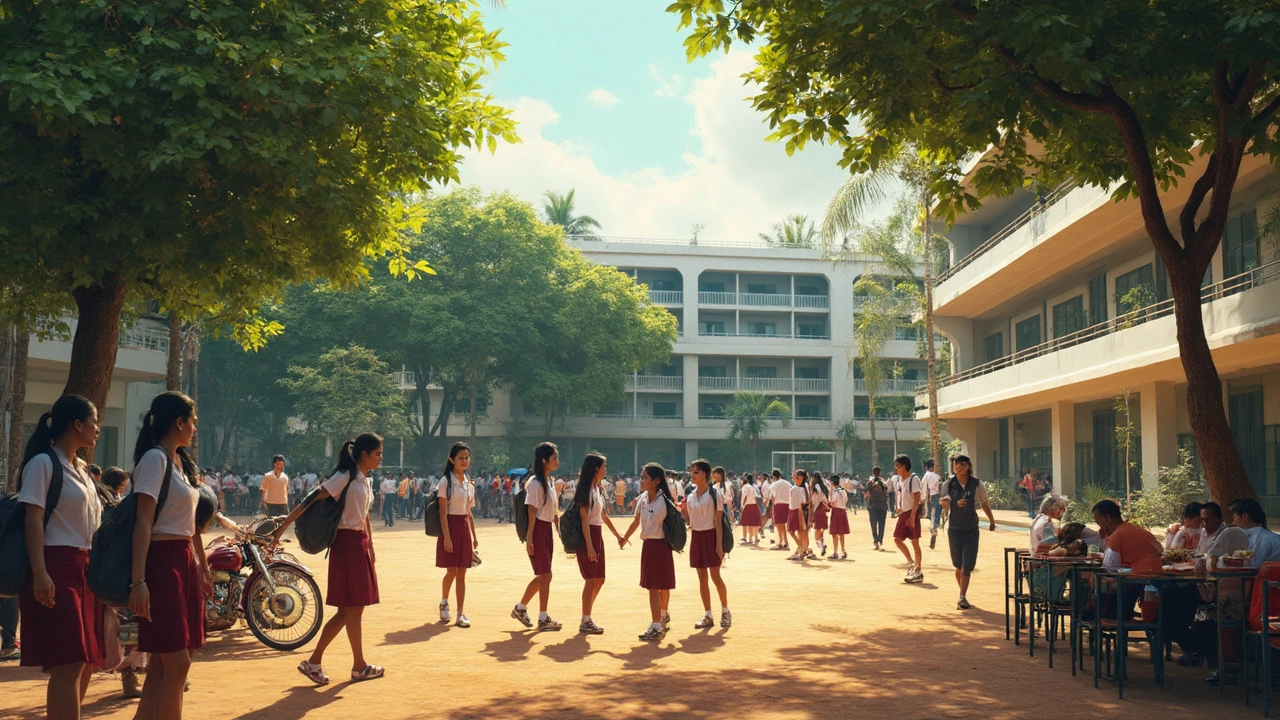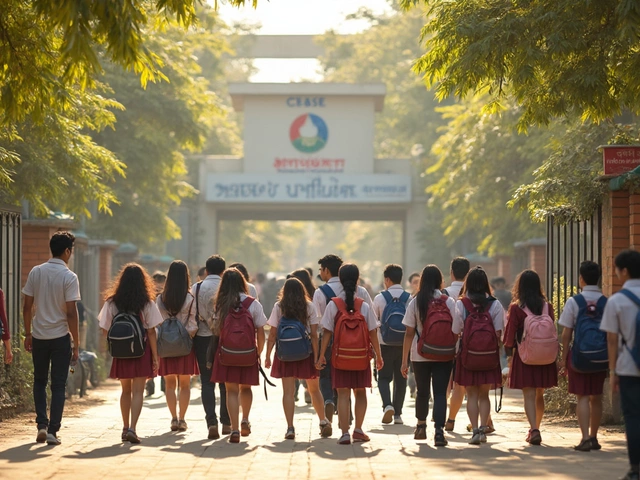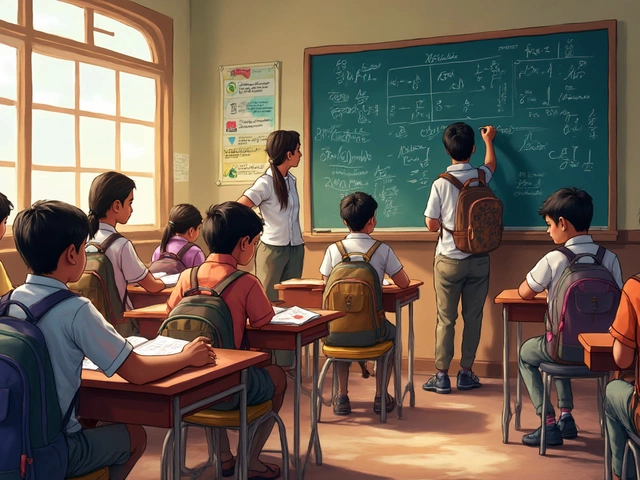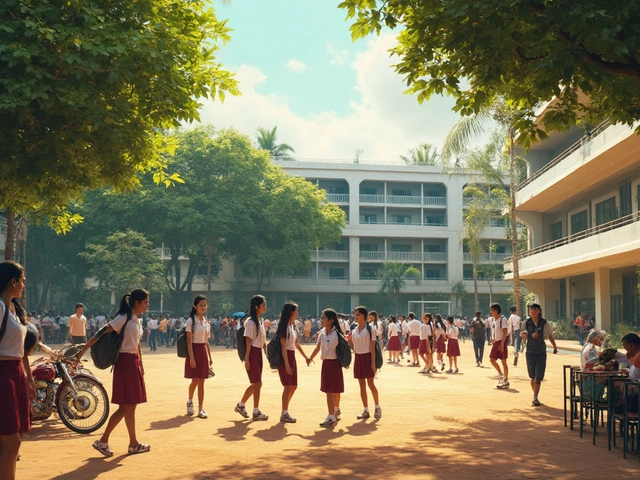People love debating which CBSE school tops the list, but there’s no one-size-fits-all answer. The numbers tell only half the story, and sometimes, the most popular schools aren’t even the best fit for every kid. So, what does ‘top’ really mean in the world of CBSE?
Parents often chase after brand names, but those don’t always guarantee great teachers or happy students. It's easy to get swept up by the glossy pictures in the prospectus, but it’s worth digging deeper before making a call.
Let’s get real: the Central Board of Secondary Education (CBSE) is known for its structured syllabus and national-level exams. But the real gems are the schools that go beyond cramming, the ones that help kids discover what they’re good at—inside and outside the textbook. In the next sections, you’ll see what helps a school rise above the rest and how you can spot a great one, even if it isn’t always trending on social media.
- What Makes a School ‘Top’ Under CBSE?
- How School Rankings Actually Work
- Schools That Set the Benchmark
- Standout Features to Watch For
- Tips to Choose the Right CBSE School
- Real Parents and Students: What Matters Most
What Makes a School ‘Top’ Under CBSE?
Everybody wants to get their kid into a top CBSE school, but what does that really look like in plain terms? It’s way more than just scoring sky-high board results. Yes, exam scores matter, but they don’t tell the whole story.
First off, top CBSE schools usually have experienced teachers with solid track records. Many keep up with modern teaching styles, use tech in classrooms, and make sure kids aren’t just memorizing stuff. The best schools regularly update their lesson plans and make things hands-on with experiments, debates, or even coding clubs.
Student-to-teacher ratio also matters. A good benchmark in Indian schools is about 25-30 students per teacher—any more, and it gets tough for a kid to get personal attention.
Facilities can make a real difference, too. We're talking computer labs, science labs, libraries that actually have books kids read, and safe sports grounds. Look for schools offering a mix of academic and non-academic activities—think art, music, and sports meets. Students who have access to these extras not only do better in boards but often win national competitions as well.
Here’s a simple table laying out some stats that usually separate the best CBSE schools from the rest:
| Factor | Top Schools | Average Schools |
|---|---|---|
| Student-Teacher Ratio | 25:1 | 40:1 |
| Pass Percentage (CBSE X & XII) | 98%+ | 80-85% |
| Extra-curricular Clubs | 8-12+ | 2-4 |
| Access to Labs/Libraries | Yes, well-equipped | Basic/limited |
| Sports/Games Facilities | Full-sized fields, regular events | Limited or none |
Another thing these schools do well? Parent-teacher communication. Top schools send out regular updates and involve parents in things beyond fee reminders. Some even have dedicated apps to track progress.
Being a topper isn’t just about cramming; it’s about the entire school experience—supportive teachers, useful facilities, and a culture that pushes kids to try new stuff, not just chase marks. That’s really what makes a CBSE school stand out from the crowd.
How School Rankings Actually Work
When people talk about the “best” CBSE schools, they're usually referring to school rankings. But most folks don’t know how these lists get made. Honestly, there’s no strict, official list straight from CBSE itself. Most school rankings come from media outlets, education consultancies, or websites, and each has its own way of picking winners.
The most obvious factor is academic performance. Schools that show off a lot of top scorers in the CBSE board exams—especially Class 10 and 12—tend to climb up the charts. For example, Delhi Public School, R.K. Puram, and The Shri Ram School regularly feature in rankings because their students often rake in high marks and national merit lists. But marks aren't everything, right?
Here’s what usually goes into a school’s rank:
- Academic results: Average board exam scores, number of toppers, and overall pass percentage.
- Infrastructure: Sports fields, libraries, labs (yes, even cool science labs and clean bathrooms count).
- Faculty experience: How well-trained and qualified the teachers are, plus how long they’ve been in the game.
- Co-curriculars: Sports teams, music, debate clubs—stuff that goes beyond worksheets.
- Student-teacher ratio: Fewer students per class usually means more personal attention.
- Parental feedback: Surveys and word-of-mouth stories from families matter more than you’d think.
Some rankings look at fee structure, alumni success, or whether the school has special support for kids who need it (think counseling or extra classes). You’ll even see categories like “Best CBSE Schools with Sports Facilities” or “Top CBSE Schools for STEM.”
One thing to remember—some schools might rank high in one area (like academics) and be average in another (like arts or sports). It’s never just about one metric. If you’re checking out these rankings, dig into the criteria instead of just staring at where a school lands on the list. It gives you way more insight into whether a school is actually the right fit.
Schools That Set the Benchmark
When people hunt for the top CBSE school, a few names always come up. But what puts these schools on the map? It’s more than just board results or swanky auditoriums. It comes down to consistency—year after year, these schools stay ahead, whether it’s academics, sports, or cultural stuff.
Take Delhi Public School (DPS), R.K. Puram in New Delhi. This place has a reputation for churning out board toppers and olympiad champions. With a strong alumni network (even a few IAS officers and tech CEOs), DPS R.K. Puram is often the first stop for ambitious students in Delhi-NCR.
DAV Schools also deserve a mention. The DAV network has a massive presence across India. Schools like DAV Public School, Chandrasekharpur in Bhubaneswar, are known for academic discipline and solid subject teaching. You’ll find their students regularly acing national-level exams—JEE, NEET, NTSE, and so on.
Then there’s National Public School (NPS), Bangalore. For anyone serious about STEM, this school’s results speak for themselves. NPS has students getting into top engineering and medical colleges almost every year. Plus, their focus on coding and research projects is next-level.
Don’t miss out on The Indian School, Muscat. NRI families in Oman swear by it for the CBSE syllabus. Their batch sizes are huge, but their student support system is solid. The pass percentage in board exams usually touches 99%—pretty wild for such a big school.
Here’s what almost all these schools have in common:
- Strong, experienced faculty with low teacher turnover
- Loads of extra-curriculars, from robotics clubs to debate teams
- Updated facilities—think modern science labs, e-learning, and smart classrooms
- Regular student counseling and mental health support
- Transparent admission process and regular PTA meetings
But even among these stars, no school is perfect for everyone. What feels like a dream school to one family might not work for the next. The trick is to spot what actually matters to your kid and match that to what these benchmark schools are offering.
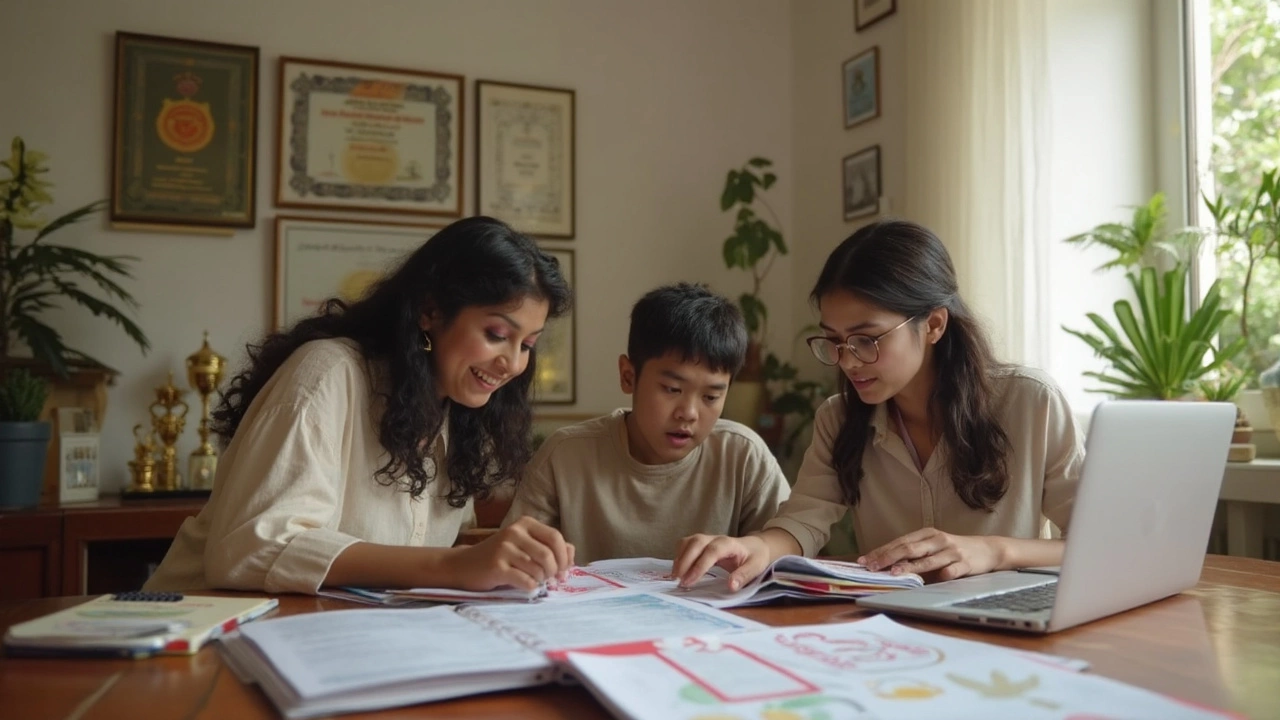
Standout Features to Watch For
If you want to spot a truly top CBSE school, forget the usual bragging about 'best infrastructure.' It pays to focus on what actually impacts learning and growth, not just the school’s social media presence. Here’s what really matters when comparing CBSE schools:
- Quality of Teachers: The best schools consistently invest in teacher training. For instance, schools like Delhi Public School and Kendriya Vidyalaya have strict teacher screening and ongoing workshops. Did you know one leading chain spends an average of 20 hours per teacher every year on CBSE-specific courses?
- Academic Results: Check out pass percentages and toppers, but don’t just stop there. Some schools post more than a 95% board exam pass rate year after year, but also focus on helping average students rise.
- Extracurriculars: Top CBSE schools give equal attention to sports, music, arts, and coding clubs. For example, The Heritage School in Gurgaon is known for its robotics lab and football coaching camps that have even produced state-level players.
- Student Support: Counselors and mentoring programs matter—a lot. Modern schools now offer regular sessions on mental wellness, career guidance, and peer mentoring. This kind of support makes a real difference when students face exam stress or tough choices.
- Modern Facilities: Wi-Fi-enabled classrooms aren’t a bonus anymore—they’re the baseline. Look for dedicated STEM labs (Science, Technology, Engineering, Math), maker spaces, and safe, tech-friendly campuses. For example, Amity International installs biometric attendance for safety and transparency.
- Global Exposure: International exchange programs and Model United Nations (MUN) clubs are big pluses. Some CBSE schools send students abroad for science fairs or language programs, which helps them learn way beyond textbooks.
Let’s get real about what sets schools apart. Take a look at this quick comparison of features based on 2024 survey data from EducationWorld India School Rankings:
| School Name | Student-Teacher Ratio | Board Results (% Above 90) | Sports Facilities | Annual Avg. Fee (INR) |
|---|---|---|---|---|
| DPS R.K. Puram | 18:1 | 65% | Olympic-grade, 10+ sports | 1,80,000 |
| The Heritage School, Gurgaon | 20:1 | 52% | Football, swimming, robotics | 2,10,000 |
| DAV Public School, Chennai | 23:1 | 48% | Basketball, chess, music club | 1,05,000 |
| Kendriya Vidyalaya | 30:1 | 38% | Cricket, NCC, computer lab | 45,000 |
What’s worth remembering? No single feature seals the deal. It’s all about balance—strong academics, open-minded staff, safe spaces, and a chance for real-world experience. Middle-of-the-road schools sometimes surprise you with what they offer on a daily basis, so keep an open mind and always visit a campus before finalizing your pick.
Tips to Choose the Right CBSE School
Picking the right school isn’t just about chasing big names. It’s more about finding the best fit for your child’s needs, goals, and everyday happiness. Here’s how you can cut through all the noise and make a smart, practical choice.
- Top CBSE school rankings are everywhere, but always visit the campus firsthand. A school might look great online, but the ground reality could be different.
- Check the quality of teachers, because solid teachers can turn even the most boring subject interesting. Ask parents or students about their experiences—it gives you the raw truth no brochure will say.
- Look for schools with balanced academics and activities. For example, Delhi Public School RK Puram is known for its excellent sports facilities and academic performance. Don’t settle for a school that only focuses on marks.
- Make sure the school has up-to-date labs, libraries, and tech. Do they have working science labs, or is the equipment always ‘getting fixed’?
- Consider class size. Smaller classes often mean more personal attention.
- Find out about the school’s past 10th and 12th board results. A good school usually posts these results on their website or notice boards.
- Ask if the teachers are regulars or if the school often has vacancies. High teacher turnover could mean deeper issues.
- Distance is practical—long commutes can tire kids out. No school is worth spending 3 hours in traffic every day.
If you want to look at the numbers, here’s a quick peek at pass rates for top CBSE schools in major cities. You can use this as a rough guide, but remember: stats don’t tell you if kids are actually enjoying learning!
| School Name | City | 2024 Class 12 Pass Rate |
|---|---|---|
| DPS RK Puram | Delhi | 99.1% |
| National Public School | Bangalore | 98.5% |
| DAV School, Mogappair | Chennai | 97.7% |
| Springdales School | Delhi | 98.2% |
| Amity International | Noida | 98.9% |
Talk to current students—most are blunt about the real pros and cons. Interpretation tip: if multiple kids roll their eyes about the labs or food, that’s a red flag.
No single school is perfect for everyone. Think about what matters most to your family: scores, exposure to sports, arts, or just an environment where your kid feels welcome. Trust your research and your gut—the simplest answers are often the best.
Real Parents and Students: What Matters Most
If you ask parents and students what actually matters in school, their checklist rarely matches those glossy awards or billboards. Forget just chasing high marks or a shiny ranking—what people really care about is whether the school helps kids grow into confident, skilled, and balanced adults. That's why reviews from real families are worth more than any fancy certificate.
Here are some concrete things parents and students from top top CBSE school picks keep mentioning over and over:
- Stress-free environment: Schools like Delhi Public School and The Shri Ram School are known for giving kids a break from the endless rat race. Parents notice the difference in their children's attitude and health.
- Teacher accessibility: Students at DAV Public School or National Public School often talk about how teachers actually listen and help, instead of just finishing the syllabus.
- Sports and clubs: Real growth happens outside the classroom too. Schools like Podar International or Modern School, Delhi, offer over 20 types of sports, drama clubs, coding, and Model UN. Kids say that’s where they pick up social skills and leadership.
- Peer groups: Ask any teenager—they'll tell you how classmates shape the whole experience. Having a positive peer circle, like at Sardar Patel Vidyalaya, boosts academic performance more than most realize.
- Safety and support: In a 2023 survey by EducationWorld, 93% of parents rated "strong safety policies" as a top reason for picking their child’s school.
The numbers below tell us what parents and students actually look for, based on a poll of 4,500 CBSE families last year:
| Factor | % Parents Ranking as Vital | % Students Ranking as Vital |
|---|---|---|
| Qualified Teachers | 81% | 78% |
| Extracurricular Options | 56% | 82% |
| Modern Infrastructure | 67% | 45% |
| Mental Health Support | 49% | 75% |
| Exam Results | 61% | 22% |
Notice how students care way more about activities and mental health support than topping exams. It’s a sign that real-life needs are shifting, and parents are following. If you’re hunting for the best CBSE school, just remember—it’s not all about the results. The little things families and students rave about may just end up mattering the most.
